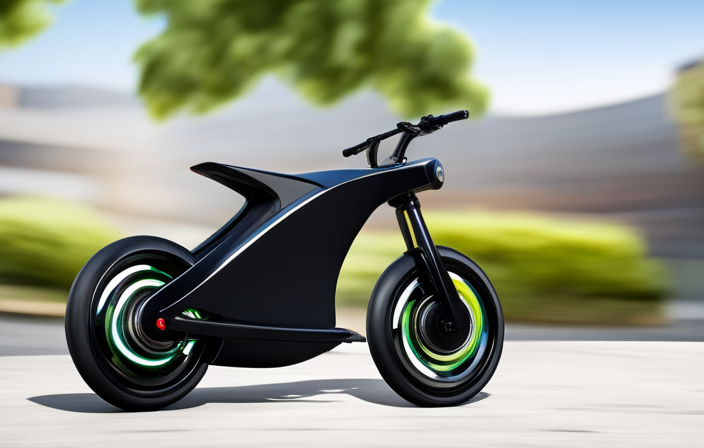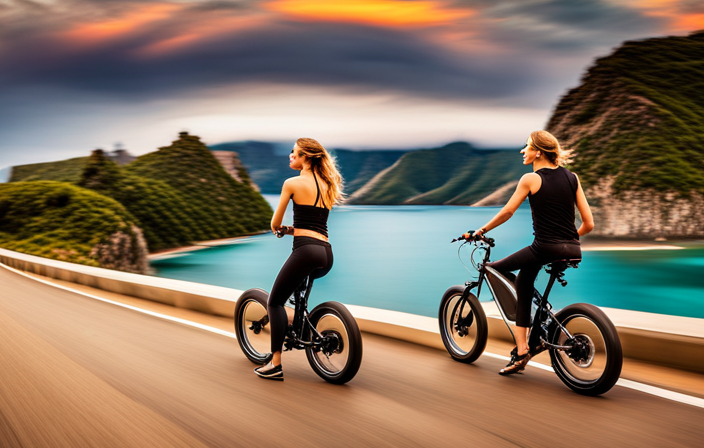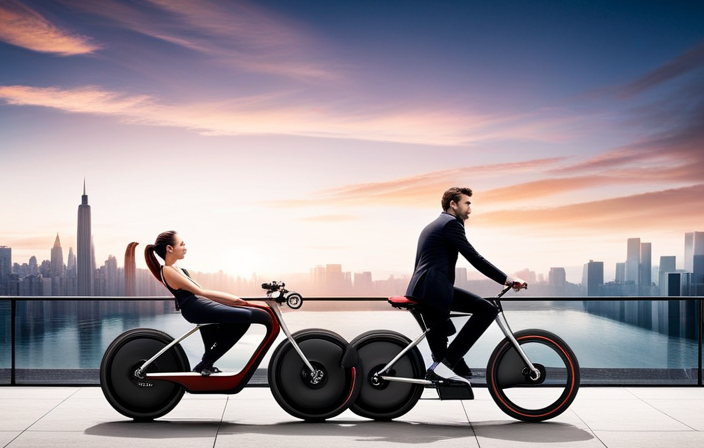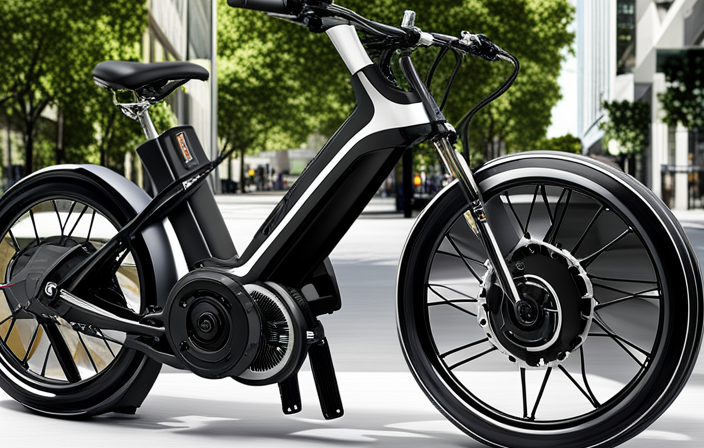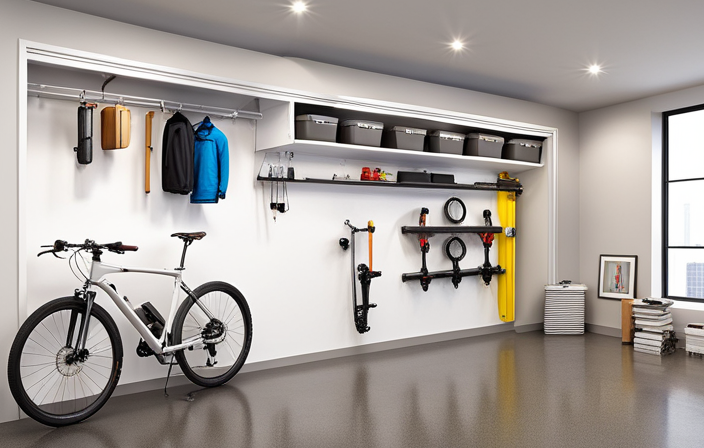They say that speed thrills, and when it comes to electric bikes, the thrill is electrifying.
Have you ever wondered just how fast these bikes can go? In this informative article, we will dive into the world of electric bike speed.
From city commutes to off-road adventures and everything in between, we will explore the factors that affect electric bike speed and provide tips for increasing it.
So buckle up and get ready to accelerate into the world of fast-paced electric biking.
Key Takeaways
- Electric bikes offer different speed modes and customization options to cater to individual preferences.
- Some electric bikes are equipped with regenerative braking systems, which contribute to overall efficiency and energy conservation.
- Safety gear and equipment, such as helmets, reflective clothing, lights, and mirrors, are crucial for safe electric bike riding.
- The fastest electric bike models can reach top speeds of up to 50 mph, surpassing traditional bikes in terms of speed.
Understanding Electric Bike Speed
Electric bikes can travel at impressive speeds, reaching up to 28 miles per hour. The speed at which an electric bike can go depends on various factors, including the type of terrain and the battery life.
Electric bikes designed for city commuting are usually built to reach higher speeds on flat, smooth roads. They are optimized for quick acceleration and can easily maintain speeds of 20 to 28 miles per hour.
On the other hand, electric mountain bikes are designed to tackle rough terrains and steep slopes, so their top speeds are generally lower, ranging from 15 to 20 miles per hour.
It’s important to note that the battery life of an electric bike can affect its speed. As the battery drains, the bike’s speed may decrease.
With this understanding of electric bike speed, let’s delve into the world of city commuter electric bikes.
City Commuter Electric Bikes
A popular option for commuting in the city is the e-bike. These electric bikes are not only eco-friendly but also offer a convenient and efficient way to navigate through city traffic. With advancements in technology, city commuter electric bikes have become faster and more reliable. They are designed to handle the challenges of urban environments, with features such as integrated lights, fenders, and racks for easy storage and transportation of belongings. Additionally, these bikes have a good battery range, allowing riders to travel longer distances without worrying about running out of power. City infrastructure plays a crucial role in supporting the use of electric bikes, with bike lanes and charging stations becoming increasingly common. Transitioning into the subsequent section about ‘off-road electric bikes,’ these e-bikes are specifically designed for more adventurous rides in rough terrains.
Off-Road Electric Bikes
When you’re ready to hit the trails, hop on an off-road e-bike for an exhilarating adventure. These bikes are designed to handle the toughest terrains and provide excellent off-road performance. With their powerful motors and rugged tires, they can conquer steep hills and rough trails with ease.
The battery range of off-road electric bikes is impressive, allowing you to ride for long distances without worrying about running out of power. Whether you’re exploring mountain trails or navigating through muddy paths, these bikes will keep you going.
They offer a smooth and stable ride, thanks to their suspension systems that absorb shocks and bumps. So get ready to experience the thrill of off-road biking on an electric bike that can handle any challenge.
Now, let’s transition into the next section about electric road bikes.
Electric Road Bikes
When it comes to electric road bikes, speed capabilities are a key consideration. These bikes are designed to reach higher speeds than traditional bicycles, allowing riders to cover more ground in less time.
Additionally, the lightweight design of electric road bikes enables faster acceleration and easier maneuverability, further enhancing their speed optimization.
Lastly, aerodynamics play a crucial role in increasing efficiency and reducing wind resistance, allowing riders to maintain higher speeds with less effort.
Speed Capabilities for Road Cycling
Electric bikes can reach impressive speeds on the road. With advancements in technology and more riders embracing electric road bikes, speed records continue to be broken. Training for speed on an electric bike involves a combination of factors, including physical fitness, bike handling skills, and understanding the capabilities of the bike itself.
Here are three important things to know about speed capabilities for road cycling on an electric bike:
-
Electric bike speed records: Riders have achieved incredible speeds on electric bikes, with some reaching over 60 miles per hour. These records demonstrate the potential of electric bikes to compete with traditional road bikes in terms of speed.
-
Training for speed on an electric bike: To maximize speed on an electric bike, it is crucial to focus on both physical training and bike handling skills. Building leg strength, improving cardiovascular fitness, and practicing efficient pedaling techniques can all contribute to increased speed.
-
Understanding the bike’s capabilities: Electric bikes have different speed modes and power levels. It is important to understand how these settings work and how they can affect your speed. Experimenting with different power levels during training rides can help you find the optimal balance between speed and battery life.
As we delve into the next section about lightweight design for speed optimization, it is important to consider how the weight of an electric bike can impact its overall performance.
Lightweight Design for Speed Optimization
A crucial factor in maximizing speed on a road bike is the use of a lightweight design. By incorporating lightweight materials into the construction of an electric bike, manufacturers are able to reduce the overall weight of the bike, allowing for faster acceleration and improved maneuverability.
Carbon fiber is a commonly used lightweight material in bike frames, as it provides strength and stiffness while being significantly lighter than traditional materials.
In addition to the materials used, the design of the bike also plays a significant role in optimizing speed. An aerodynamic design reduces wind resistance, allowing the bike to cut through the air more efficiently.
This combination of lightweight materials and aerodynamic design is essential for achieving maximum speed on an electric bike.
Moving forward, the next section will explore the importance of aerodynamics for increased efficiency.
Aerodynamics for Increased Efficiency
Maximizing efficiency on a road bike can be achieved by optimizing aerodynamics. Aerodynamic advancements play a crucial role in increasing the speed and overall performance of electric bikes. By reducing wind resistance, these advancements allow the bike to slice through the air more smoothly, resulting in higher speeds and improved powertrain efficiency.
One key aspect of aerodynamics is the design of the bike frame, which is often shaped to minimize drag and turbulence. Additionally, components such as handlebars, wheels, and even the rider’s position can be optimized for better aerodynamic performance.
These advancements not only enhance the speed of electric bikes but also contribute to their overall energy efficiency, allowing riders to travel longer distances on a single charge.
Moving on to factors affecting electric bike speed, the weight of the bike and its components plays a significant role in determining how fast it can go.
Factors Affecting Electric Bike Speed
One factor that affects how fast electric bikes go is the weight of the rider.
The understanding of motor power and battery capacity also plays a significant role in determining the speed of an electric bike.
The motor power directly affects the bike’s acceleration and top speed. Higher motor power allows the bike to reach higher speeds more quickly.
Similarly, the battery capacity affects the distance an electric bike can cover on a single charge. A larger battery capacity provides more power for the motor, enabling the bike to maintain higher speeds for longer durations.
These factors, along with the weight of the rider, contribute to the overall speed capabilities of an electric bike.
Moving on to speed control and safety measures, it is important to consider various factors to ensure a safe and controlled riding experience.
Speed Control and Safety Measures
To ensure a safe and controlled riding experience, it is crucial to implement effective speed control and safety measures.
When it comes to speed control techniques, electric bikes typically have different modes that allow riders to adjust the level of assistance provided by the motor. These modes can range from eco-friendly options that limit speed and conserve battery power, to higher performance settings that provide a boost in speed.
Additionally, some electric bikes are equipped with regenerative braking systems, which help control speed by converting the bike’s kinetic energy back into electrical energy.
As for safety gear and equipment, it is important to wear a helmet to protect the head in case of accidents. Other safety measures include using reflective clothing, lights, and mirrors to enhance visibility on the road.
Now, let’s move on to the exciting world of top speed models on the market.
Top Speed Models on the Market
Now, let’s take a look at some of the fastest models available on the market.
Here are four electric bikes that have set impressive speed records:
-
The Stealth Electric Bikes Bomber: With a top speed of 50 mph, this bike is a true speed demon.
-
The Specialized Turbo Levo SL: This powerful electric mountain bike can reach speeds of up to 28 mph, making it a great option for off-road adventures.
-
The Ariel Rider X-Class: With a top speed of 30 mph, this electric bike combines style and speed, perfect for urban commuting.
-
The Riese & Müller Supercharger2 GT Rohloff: This premium electric bike can reach speeds of up to 28 mph and offers a comfortable and luxurious riding experience.
Electric bikes have come a long way in terms of speed, often surpassing traditional bikes. These models prove that electric bikes can compete with and even outperform their non-electric counterparts.
In the next section, we will discuss tips for increasing electric bike speed without compromising safety.
Tips for Increasing Electric Bike Speed
When it comes to increasing electric bike speed, there are several key points to consider.
First and foremost, regular maintenance and tune-ups are essential to keep your bike running smoothly and efficiently.
Secondly, proper tire inflation and tread can greatly impact your bike’s speed and performance.
Lastly, reducing weight and utilizing bike accessories can also contribute to a faster and more enjoyable ride.
By focusing on these areas, you can maximize the speed and efficiency of your electric bike.
Regular Maintenance and Tune-Ups
Make sure you regularly maintain and tune up your electric bike. Regular maintenance is crucial for keeping your bike in optimal condition and ensuring its longevity. It is recommended to follow the manufacturer’s guidelines for maintenance intervals, which may include tasks such as cleaning and lubricating the chain, checking and adjusting the brakes, and inspecting the frame for any signs of damage.
Additionally, consider performance upgrades that can enhance your bike’s speed and overall performance. This may include upgrading the battery, motor, or controller. By regularly maintaining your electric bike and considering performance upgrades, you can maximize its speed and efficiency.
Proper tire inflation and tread is another important aspect to consider in order to further optimize your bike’s performance and speed.
Proper Tire Inflation and Tread
To optimize your riding experience, ensure that your tires are properly inflated and have the right tread pattern. Here are some key points to consider:
-
Tire Pressure: Maintaining the correct tire pressure is crucial for electric bike performance. Check the manufacturer’s guidelines to determine the recommended tire pressure. Proper inflation ensures optimal grip and handling while reducing the risk of flats.
-
Tire Grip: The tread pattern on your electric bike tires plays a significant role in determining traction. Different tread patterns are designed for specific terrains, such as smooth roads or off-road trails. Choose a tread pattern that suits your riding style and the surfaces you frequently encounter.
-
Regular Inspection: Regularly inspect your tires for any signs of wear, such as cracks, bulges, or uneven tread wear. Replace worn-out tires promptly to maintain safety and performance.
-
Tire Maintenance: Keep your tires clean and free from debris. Remove any embedded objects that could cause punctures or affect tire grip.
By ensuring proper tire inflation and tread, you can enhance your electric bike’s performance and riding experience.
In the next section, we will explore weight reduction and bike accessories to further optimize your ride.
Weight Reduction and Bike Accessories
One way to enhance your riding experience is by reducing weight on your electric bike and adding accessories. By modifying your bike to be lighter, you can increase its speed and maneuverability. One effective method of weight reduction is upgrading to a lighter frame material, such as carbon fiber. Additionally, you can replace heavy components like the seat, pedals, and handlebars with lighter alternatives. Another aspect to consider is adding accessories that can improve your riding experience, such as a more aerodynamic helmet or a handlebar-mounted smartphone holder for navigation. To give you an idea of the impact these modifications can have, here is a table showing the weight reduction and speed improvements achieved by different bike accessories:
| Accessory | Weight Reduction (lbs) | Speed Improvement (mph) |
|---|---|---|
| Carbon Fiber Frame | 2.5 | 3 |
| Lightweight Seat | 0.5 | 0.5 |
| Carbon Fiber Pedals | 0.3 | 0.2 |
| Aero Helmet | 0.2 | 0.3 |
| Smartphone Holder | 0.1 | 0.1 |
By reducing weight and adding these accessories, you can significantly enhance the performance of your electric bike. Now, let’s move on to the legal considerations for electric bike speed.
Legal Considerations for Electric Bike Speed
When it comes to electric bikes, it’s important to consider the legal limitations on their speed. Electric bike regulations vary from country to country and even within different regions, so it’s crucial to understand the specific rules in your area.
In some places, electric bikes are classified as bicycles and are subject to the same speed limits as regular bikes. This means that typically, electric bikes are not allowed to exceed speeds of 20 mph (32 km/h). However, there are also areas where electric bikes are considered motor vehicles and are subject to higher speed limits.
Whatever the case may be, it’s important to prioritize safety when riding an electric bike. Always follow the speed limits and exercise caution on the road.
Conclusion: Finding the right speed for you is essential for a safe and enjoyable electric bike experience.
Conclusion: Finding the Right Speed for You
In order to have a safe and enjoyable experience with your electric bike, it is crucial to find the speed that suits you best. Finding the optimal speed involves considering various factors such as your skill level, the terrain you will be riding on, and any legal limitations in your area. Maintaining a speed that you are comfortable with will ensure that you have better control over your bike and can react quickly to any obstacles or hazards that may arise. To help you determine the right speed for you, consider the following table:
| Skill Level | Terrain | Legal Limitations |
|---|---|---|
| Beginner | Flat | 20 mph |
| Intermediate | Hilly | 28 mph |
| Advanced | Mountain | 35 mph |
By matching your skill level, terrain, and legal limitations, you can find the speed that allows you to ride comfortably and confidently. Remember, safety should always be a priority when riding an electric bike.
Frequently Asked Questions
Can electric bikes go faster than regular bicycles?
Yes, electric bikes can go faster than regular bicycles. They have a motor that provides additional power, allowing them to reach higher speeds. This is one of the advantages of electric bikes compared to scooters.
Are there any speed limits for electric bikes?
There are speed limits for electric bikes, which vary depending on the country or state. Exceeding these limits can result in fines and penalties. Additionally, higher speeds can negatively impact the battery life of an electric bike.
How long does it take for an electric bike to reach its top speed?
To reach its top speed, an electric bike’s acceleration depends on various factors such as the power of the motor, the weight of the bike and rider, and the terrain. It can take a few seconds to a minute or more, depending on these factors.
Can the speed of an electric bike be adjusted according to the rider’s preference?
Yes, the speed of an electric bike can be easily adjusted to suit the rider’s preference. With adjustable speed control, you can cruise at a comfortable pace or zoom along at exhilarating speeds.
Are there any safety features in place to prevent accidents due to high speeds on electric bikes?
Safety standards for electric bikes include speed limiters and automatic braking systems to prevent accidents due to high speeds. It is also important for riders to wear helmets to protect themselves in case of a fall or collision.
Conclusion
In conclusion, finding the right speed for you on an electric bike is crucial for an enjoyable riding experience. Whether you are a city commuter, an off-road enthusiast, or a road cyclist, there is an electric bike that suits your needs.
Factors such as motor power, battery capacity, and terrain can affect the speed of an electric bike. Remember, safety should always be a priority when riding at high speeds.
So, go ahead and find the perfect electric bike that will make you feel like you’re soaring through the wind with lightning speed!
